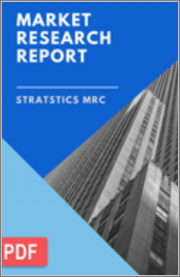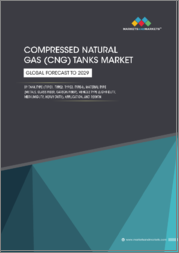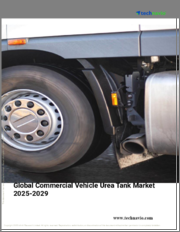
|
시장보고서
상품코드
1383310
작동 유체 리저버 탱크 시장 예측(-2030년) : 재료 유형, 용량, 최종사용자, 지역별 세계 분석Hydraulic Fluid Reservoir Tank Market Forecasts to 2030 - Global Analysis By Material Type (Aluminum, Steel, Stainless and Other Material Types), Capacity (Large, Medium and Small), End User and By Geography |
||||||
Stratistics MRC에 따르면 세계의 작동 유체 리저버 탱크 시장은 2023년에 190억 4,000만 달러를 차지하고 예측 기간 중 CAGR은 7.1%로 성장하며, 2030년에는 307억 달러에 달할 전망입니다.
유압 저장소는 시스템에 공급하는 데 필요한 유압 유체를 담는 용기이며, 약간의 누출이나 증발로 인한 손실을 충당하기 위한 예비도 포함되어 있습니다. 주요 기능은 유압 시스템에 작동 유체(일반적으로 작동 유체)를 공급하고 저장하는 것입니다. 유압 시스템 작동 중에 발생하는 열을 방출하여 작동 유체를 이상적인 온도로 유지하는 데 도움이 됩니다.
산업의 확장
산업이 확대되고 다양화됨에 따라 유압 시스템을 동력원으로 하는 기계 설비에 대한 요구가 증가하고 있습니다. 이러한 시스템에는 유체를 저장하고 냉각하는 유체 저장 탱크가 필수적입니다. 자동화, 광업, 제조업, 건설업, 농업 등 산업의 성장은 유압유체 저장 탱크 수요에 직접적인 영향을 미칩니다. 또한 제조업은 플라스틱 성형, 금속 가공 등 많은 작업에서 유압 시스템을 필요로 합니다. 이러한 요소들이 시장 성장을 가속하고 있습니다.
재료비
유체 저장 탱크 시장을 제약하는 주요 요인 중 하나는 재료 비용입니다. 이 탱크의 제조에는 주로 강철, 알루미늄 및 특수 복합재료가 사용되기 때문에 이러한 원자재 가격의 변동은 제조 비용에 직접적인 영향을 미칠 수 있습니다. 또한 작동유 저장 탱크 시장은 특히 공급망이 부족하거나 중단되는 시기에 우수한 재료의 안정적인 공급에 어려움을 겪을 수 있습니다.
기술의 진보
유체 저장 탱크 시장을 촉진하는 주요 요인 중 하나는 기술 발전입니다. 혁신적인 기술은 현대 산업 용도에서 지속적인 사용을 보장하는 정교한 기능과 기능을 갖춘 저수지 탱크를 만들어냈습니다. 유체 레벨, 온도, 압력, 오염에 대한 실시간 정보는 센서가 장착된 스마트 저수지 탱크에서 얻을 수 있습니다. 이를 통해 예측 유지보수가 가능하여 다운타임을 줄이고 유압 시스템의 신뢰성을 향상시킬 수 있습니다. 모든 것을 고려할 때 기술 발전은 유압 유체 저장 탱크 시장의 확대와 혁신에 필수적입니다.
환경문제
환경 문제는 작동유 저장 탱크 시장에 큰 위협이 되고 있습니다. 유압 시스템에서 누출이 발생하여 작동유가 주변으로 유출 될 수 있습니다. 이는 물과 토양을 오염시킬 수 있으며 야생 동물과 생태계에 해로울 수 있습니다. 유압 시스템을 사용하는 기업은 규제 강화와 환경 파괴에 대한 사회적 감시가 강화됨에 따라 부채와 경제적 영향에 직면 할 수 있습니다. 유압 시스템이 환경에 미치는 악영향을 줄이기 위해 정부 및 환경 단체는 엄격한 규정을 시행하고 있습니다. 이러한 법률에는 고급 작동유 관리 기술과 누출 방지 저수지 탱크의 사용이 포함됩니다.
COVID-19의 영향
COVID-19 팬데믹은 유체 저장 탱크 시장에 큰 영향을 미쳤습니다. 세계 공급망의 혼란으로 인해 제조가 지연되고 비용이 증가하여 저수지 탱크공급 능력에 영향을 미쳤습니다. 봉쇄와 불투명한 경제 상황으로 인해 항공우주, 자동차, 건설 및 기타 산업에서 유압 장비에 대한 수요가 감소했습니다. 생산 라인의 중단은 노동 문제로 인해 발생했으며 일부 기업은 재정적 제약으로 인해 유압 장비에 대한 투자를 연기했습니다.
예측 기간 중 알루미늄 부문이 가장 큰 비중을 차지할 것으로 예상
알루미늄 부문이 가장 큰 점유율을 차지하는 것으로 추정됩니다. 알루미늄은 탱크 제조에 적합하기 때문에 인기가 높습니다. 알루미늄은 강도와 경량성 때문에 내구성과 경량화가 중요한 유압 시스템에서 중요한 소재입니다. 또한 알루미늄은 내식성이 우수하여 작동유체 밀폐가 필수적인 용도에 적합합니다. 또한 알루미늄의 우수한 열전도율은 유압 작동 중에 발생하는 열을 방출하는 데 도움이 됩니다.
예측기간 중 가장 높은 CAGR을 기록할 것으로 예상되는 분야는 자동차 분야
자동차 분야는 예측 기간 중 유리한 성장세를 보일 것으로 예상됩니다. 자동차 분야에서 작동유 저장 탱크는 자동차의 일반적인 효율성과 안전에 필수적입니다. 이 탱크는 작동유를 저장하고 파워 스티어링, 브레이크, 서스펜션 시스템과 같은 자동차 유압 시스템의 다양한 컴포넌트에 동력을 공급하는 데 필수적인 역할을 합니다. 작동유 탱크는 브레이크를 효율적으로 작동시키기에 충분한 작동유 공급을 보장하여 안정적이고 반응이 빠른 제동력을 제공합니다. 작동유 탱크는 유압 시스템의 원활한 작동을 보장하고 핸들링, 제동 및 전체 차량 성능을 향상시키는 중요한 컴포넌트입니다.
가장 큰 점유율을 차지하는 지역
북미가 가장 큰 시장 점유율을 차지하고 있습니다. 이 지역의 제조, 건설, 농업 및 운송 부문은 유압 시스템에 크게 의존하고 있으며, 이러한 저장 솔루션에 대한 수요가 지속적으로 증가하고 있습니다. 북미는 엄격한 규제 환경이 확립되어 있으며, 제품 설계 및 생산에 있으며, 환경 및 안전 표준이 중요한 고려 사항입니다. 따라서 규정 준수 요건을 충족하기 위해 고품질의 기술적으로 진보된 저수지 탱크가 개발되는 경우가 많습니다. 자동차, 항공우주, 석유 및 가스, 농업 등 다양한 산업이 수요를 주도하는 미국은 유체 저장 탱크 시장의 주요 시장입니다.
CAGR이 가장 높은 지역 :
아시아태평양은 예측 기간 중 수익성 있는 성장을 이룰 것으로 예상됩니다. 아시아태평양의 작동유 저수지 탱크 시장의 주요 촉진요인 중 하나는 탄탄한 제조 부문입니다. 이 지역은 세계 제조업의 중심지로서 제조업, 광업, 건설, 농업 등 다양한 분야에서 저수지 탱크를 포함한 유압 시스템에 대한 수요가 활발하게 일어나고 있습니다. 또한 아시아태평양의 자동차 및 항공우주 산업이 확대됨에 따라 착륙 장비 및 브레이크 용도의 저수지 탱크를 포함한 유압 시스템에 대한 수요가 증가하고 있습니다. 빠르게 성장하는 재생 에너지 산업, 특히 풍력 및 태양광발전은 유압 시스템에 의존하기 때문에 저수지 탱크가 필요합니다.
무료 커스터마이즈 서비스
본 리포트를 구독하는 고객에게는 아래의 무료 커스터마이즈 옵션 중 하나를 제공합니다. :
- 기업 개요
- 추가 시장 기업의 종합적 프로파일링(최대 3사)
- 주요 기업의 SWOT 분석(최대 3사)
- 지역 세분화
- 고객의 관심에 따른 주요 국가의 시장 추산·예측·CAGR(주 : 타당성 체크에 따라 제공)
- 경쟁 벤치마킹
- 제품 포트폴리오, 지역적 입지, 전략적 제휴에 기반한 주요 기업의 벤치마킹
목차
제1장 주요 요약
제2장 서문
- 개요
- 이해관계자
- 조사 범위
- 조사 방법
- 데이터 마이닝
- 데이터 분석
- 데이터 검증
- 조사 어프로치
- 조사 소스
- 1차 조사 소스
- 2차 조사 소스
- 전제조건
제3장 시장 동향 분석
- 촉진요인
- 억제요인
- 기회
- 위협
- 최종사용자 분석
- 신흥 시장
- 신종 코로나바이러스 감염증(COVID-19)의 영향
제4장 Porter's Five Forces 분석
- 공급 기업의 교섭력
- 구매자의 교섭력
- 대체품의 위협
- 신규 진출업체의 위협
- 경쟁 기업간 경쟁 관계
제5장 세계의 작동 유체 리저버 탱크 시장 : 재료 유형별
- 알루미늄
- 강철
- 스테인리스
- 기타
제6장 세계의 작동 유체 리저버 탱크 시장 : 용량별
- 대형
- 중형
- 소형
제7장 세계의 작동 유체 리저버 탱크 시장 : 최종사용자별
- 석유 및 가스
- 건설
- 자동차
- 운송기관
- 기타
제8장 세계의 작동 유체 리저버 탱크 시장 : 지역별
- 북미
- 미국
- 캐나다
- 멕시코
- 유럽
- 독일
- 영국
- 이탈리아
- 프랑스
- 스페인
- 기타 유럽
- 아시아태평양
- 일본
- 중국
- 인도
- 호주
- 뉴질랜드
- 한국
- 기타 아시아태평양
- 남미
- 아르헨티나
- 브라질
- 칠레
- 기타 남미
- 중동 및 아프리카
- 사우디아라비아
- 아랍에미리트
- 카타르
- 남아프리카공화국
- 기타 중동 및 아프리카
제9장 주요 발전
- 계약, 파트너십, 협업, 합병사업
- 인수합병
- 신제품 발매
- 사업 확대
- 기타 주요 전략
제10장 기업 개요
- Hydro-Craft
- Propower
- HBE GmbH
- Maxwell Industries
- Helgesen
- SMA Serbatoi
- Standard Technologies
- PADOAN GROUP
- Hilton Manufacturing
- Salzburger Aluminium Group
- IFH Group
- Elkamet
- Northside Industries
- American Mobile Power
- Roadrunner Manufacturing
According to Stratistics MRC, the Global Hydraulic Fluid Reservoir Tank Market is accounted for $19.04 billion in 2023 and is expected to reach $30.7 billion by 2030 growing at a CAGR of 7.1% during the forecast period. The hydraulic reservoir is a container for holding the fluid required to supply the system, including a reserve to cover any losses from minor leakage and evaporation. Its main function is to supply and store hydraulic fluid, typically hydraulic oil, for the hydraulic system. It helps to keep the fluid at its ideal temperature by allowing heat produced during hydraulic system operation to dissipate.
Market Dynamics:
Driver:
Expansion of industries
The need for machinery and equipment driven by hydraulic systems rises in conjunction with the expansion and diversification of industries. In these systems, hydraulic fluid reservoir tanks are essential because they store and cool hydraulic fluids. The growth of industries like automation, mining, manufacturing, construction, and agriculture has a direct effect on the demand for hydraulic fluid reservoir tanks. Moreover, hydraulic systems are necessary in the manufacturing sector for a number of operations, such as plastic molding and metalworking. These elements are propelling market growth.
Restraint:
Material costs
One major factor constraining the hydraulic fluid reservoir tank market is material costs. Since steel, aluminum, and specialty composites are the main materials used to make these tanks, changes in the price of these raw materials can directly affect the cost of production. In addition, the market for hydraulic fluid reservoir tanks may encounter difficulties in obtaining a steady supply of superior materials, particularly in periods of shortage or interruptions in the supply chain.
Opportunity:
Technological advancements
One major factor boosting the hydraulic fluid reservoir tank market is technological advancements. Innovative technologies can result in the creation of reservoir tanks with sophisticated features and functionalities, guaranteeing their continued use in contemporary industrial applications. Real-time information on fluid levels, temperature, pressure, and contamination can be obtained from smart reservoir tanks that have sensors installed in them. This makes predictive maintenance possible, which lowers downtime and raises hydraulic systems' dependability. All things considered, technological advancements are essential to the market's expansion and innovation for hydraulic fluid reservoir tanks.
Threat:
Environmental concerns
Environmental concerns pose a significant threat to the Hydraulic Fluid Reservoir Tank Market. Leaks can occur in hydraulic systems, causing hydraulic fluid to spill into the surrounding area. This can contaminate water and soil, which would be harmful for wildlife and ecosystems. Businesses that use hydraulic systems might face liabilities and economic consequences as a result of stricter regulations and increased public scrutiny of environmental damage. Stricter rules are being implemented by governments and environmental organizations to reduce the negative effects of hydraulic systems on the environment. These laws include the use of advanced fluid management technologies and reservoir tanks that are resistant to leaks.
COVID-19 Impact
The COVID-19 pandemic had a notable impact on the hydraulic fluid reservoir tank market. Disruptions in global supply chains led to manufacturing delays and increased costs, affecting the availability of reservoir tanks. The need for hydraulic equipment dropped in industries like aerospace, automotive, and construction as a result of lockdowns and uncertain economic conditions. Production line interruptions were caused by labor issues, and some businesses postponed investing in hydraulic equipment due to financial constraints.
The aluminum segment is expected to be the largest during the forecast period
The aluminum segment is estimated to hold the largest share. Its favourable qualities that make it a good option for producing these tanks account for its popularity. Because of its popularity for being both strong and lightweight, aluminum is a valuable material for hydraulic systems where durability and weight reduction are crucial. Additionally, because of its strong resistance to corrosion, it is perfect for uses where hydraulic fluid containment is essential. Furthermore, the superior thermal conductivity of aluminum aids in the dissipation of heat produced during hydraulic operations.
The automotive segment is expected to have the highest CAGR during the forecast period
The automotive segment is anticipated to have lucrative growth during the forecast period. In the automotive sector, hydraulic fluid reservoir tanks are essential to the general efficiency and security of automobiles. These tanks store hydraulic fluid, which is essential for powering various components within a vehicle's hydraulic system, including power steering, brakes, and suspension systems. The hydraulic fluid reservoir guarantees that there is a sufficient supply of fluid to operate the brakes efficiently, delivering dependable and responsive stopping power. Tanks for hydraulic fluid are essential parts that guarantee the smooth operation of hydraulic systems, which improves handling, braking, and overall vehicle performance.
Region with largest share:
North America commanded the largest market share during the extrapolated. The region's manufacturing, construction, agriculture, and transportation sectors rely heavily on hydraulic systems, creating a consistent need for these storage solutions. North America has a well-established and strict regulatory environment, and environmental and safety standards are important considerations in the design and production of products. This often results in the development of high-quality and technologically advanced reservoir tanks to meet compliance requirements. With a wide range of industries driving demand, including automotive, aerospace, oil and gas, and agriculture, the United States is a major player in the hydraulic fluid reservoir tank market.
Region with highest CAGR:
Asia Pacific is expected to witness profitable growth over the projection period. One of the key drivers of the hydraulic fluid reservoir tank market in the Asia-Pacific region is its robust manufacturing sector. As a hub for global manufacturing, the region supports the strong demand for hydraulic systems, including reservoir tanks, across a range of sectors, including manufacturing, mining, construction, and agriculture. Additionally, there is a greater need for hydraulic systems, including reservoir tanks, for landing gear and brake applications as a result of the expansion of the automotive and aerospace industries in the Asia-Pacific region. Reservoir tanks are necessary because the rapidly growing renewable energy industry, especially wind and solar power, depends on hydraulic systems.
Key players in the market
Some of the key players in the Hydraulic Fluid Reservoir Tank Market include: Hydro-Craft, Propower, HBE GmbH, Maxwell Industries, Helgesen, SMA Serbatoi, Standard Technologies, PADOAN GROUP, Hilton Manufacturing, Salzburger Aluminium Group, IFH Group, Elkamet, Northside Industries, American Mobile Power and Roadrunner Manufacturing.
Key Developments:
In October 2023, Roadrunner, transportation's greatest comeback story, unveiled its new Smart Guarantee LTL service offering. The priority service ensures less-than-truckload (LTL) freight delivers by the promised delivery date or it's free.
In June 2022, NorthSide Announces Venture Incubator and Brand Builder Programs to Scale Brands in India. The program helps nurture the idea into a viable business by providing insights generation, positioning development, creative asset development, and e-commerce scale-up, all under one roof.
Material Types Covered:
- Aluminum
- Steel
- Stainless
- Other Material Types
Capacities Covered:
- Large
- Medium
- Small
End Users Covered:
- Oil and Gas
- Construction
- Automotive
- Transportation
- Other End Users
Regions Covered:
- North America
- US
- Canada
- Mexico
- Europe
- Germany
- UK
- Italy
- France
- Spain
- Rest of Europe
- Asia Pacific
- Japan
- China
- India
- Australia
- New Zealand
- South Korea
- Rest of Asia Pacific
- South America
- Argentina
- Brazil
- Chile
- Rest of South America
- Middle East & Africa
- Saudi Arabia
- UAE
- Qatar
- South Africa
- Rest of Middle East & Africa
What our report offers:
- Market share assessments for the regional and country-level segments
- Strategic recommendations for the new entrants
- Covers Market data for the years 2021, 2022, 2023, 2026, and 2030
- Market Trends (Drivers, Constraints, Opportunities, Threats, Challenges, Investment Opportunities, and recommendations)
- Strategic recommendations in key business segments based on the market estimations
- Competitive landscaping mapping the key common trends
- Company profiling with detailed strategies, financials, and recent developments
- Supply chain trends mapping the latest technological advancements
Free Customization Offerings:
All the customers of this report will be entitled to receive one of the following free customization options:
- Company Profiling
- Comprehensive profiling of additional market players (up to 3)
- SWOT Analysis of key players (up to 3)
- Regional Segmentation
- Market estimations, Forecasts and CAGR of any prominent country as per the client's interest (Note: Depends on feasibility check)
- Competitive Benchmarking
- Benchmarking of key players based on product portfolio, geographical presence, and strategic alliances
Table of Contents
1 Executive Summary
2 Preface
- 2.1 Abstract
- 2.2 Stake Holders
- 2.3 Research Scope
- 2.4 Research Methodology
- 2.4.1 Data Mining
- 2.4.2 Data Analysis
- 2.4.3 Data Validation
- 2.4.4 Research Approach
- 2.5 Research Sources
- 2.5.1 Primary Research Sources
- 2.5.2 Secondary Research Sources
- 2.5.3 Assumptions
3 Market Trend Analysis
- 3.1 Introduction
- 3.2 Drivers
- 3.3 Restraints
- 3.4 Opportunities
- 3.5 Threats
- 3.6 End User Analysis
- 3.7 Emerging Markets
- 3.8 Impact of Covid-19
4 Porters Five Force Analysis
- 4.1 Bargaining power of suppliers
- 4.2 Bargaining power of buyers
- 4.3 Threat of substitutes
- 4.4 Threat of new entrants
- 4.5 Competitive rivalry
5 Global Hydraulic Fluid Reservoir Tank Market, By Material Type
- 5.1 Introduction
- 5.2 Aluminum
- 5.3 Steel
- 5.4 Stainless
- 5.5 Other Material Types
6 Global Hydraulic Fluid Reservoir Tank Market, By Capacity
- 6.1 Introduction
- 6.2 Large
- 6.3 Medium
- 6.4 Small
7 Global Hydraulic Fluid Reservoir Tank Market, By End User
- 7.1 Introduction
- 7.2 Oil and Gas
- 7.3 Construction
- 7.4 Automotive
- 7.5 Transportation
- 7.6 Other End Users
8 Global Hydraulic Fluid Reservoir Tank Market, By Geography
- 8.1 Introduction
- 8.2 North America
- 8.2.1 US
- 8.2.2 Canada
- 8.2.3 Mexico
- 8.3 Europe
- 8.3.1 Germany
- 8.3.2 UK
- 8.3.3 Italy
- 8.3.4 France
- 8.3.5 Spain
- 8.3.6 Rest of Europe
- 8.4 Asia Pacific
- 8.4.1 Japan
- 8.4.2 China
- 8.4.3 India
- 8.4.4 Australia
- 8.4.5 New Zealand
- 8.4.6 South Korea
- 8.4.7 Rest of Asia Pacific
- 8.5 South America
- 8.5.1 Argentina
- 8.5.2 Brazil
- 8.5.3 Chile
- 8.5.4 Rest of South America
- 8.6 Middle East & Africa
- 8.6.1 Saudi Arabia
- 8.6.2 UAE
- 8.6.3 Qatar
- 8.6.4 South Africa
- 8.6.5 Rest of Middle East & Africa
9 Key Developments
- 9.1 Agreements, Partnerships, Collaborations and Joint Ventures
- 9.2 Acquisitions & Mergers
- 9.3 New Product Launch
- 9.4 Expansions
- 9.5 Other Key Strategies
10 Company Profiling
- 10.1 Hydro-Craft
- 10.2 Propower
- 10.3 HBE GmbH
- 10.4 Maxwell Industries
- 10.5 Helgesen
- 10.6 SMA Serbatoi
- 10.7 Standard Technologies
- 10.8 PADOAN GROUP
- 10.9 Hilton Manufacturing
- 10.10 Salzburger Aluminium Group
- 10.11 IFH Group
- 10.12 Elkamet
- 10.13 Northside Industries
- 10.14 American Mobile Power
- 10.15 Roadrunner Manufacturing



















